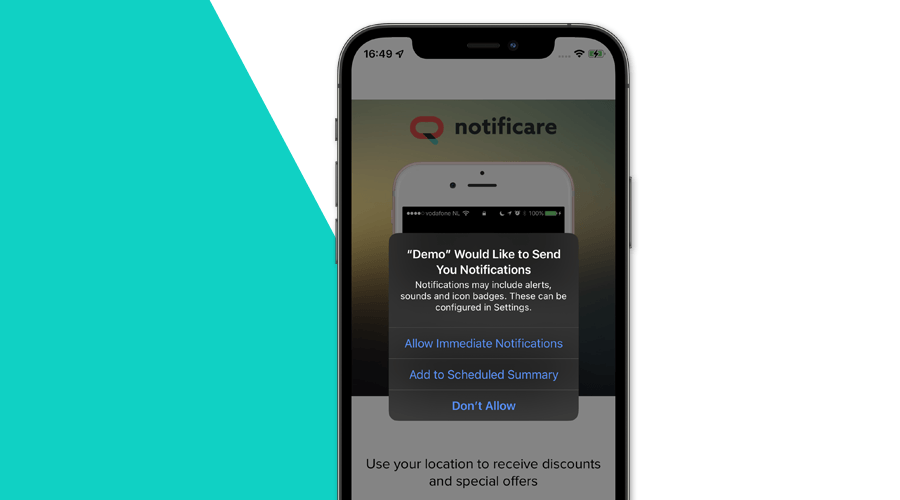In a previous post, we've covered what will change in Android 12 and iOS 15. In this post, we would like to dive a bit deeper on how these changes will impact iOS push notifications in particular.
In iOS 15, the introduction of features like Focus (replacing the Do Not Disturb) and Notification Summary, will fundamentally change how users consume notifications from apps. These new features are not enabled by default but brands should expect mass adoption in a very short amount of time.
For those users that do not enable Notification Summary, not much changes. Your app will not require any changes to keep delivering push notifications as it does right now. Without enabling Notification Summary, apps requesting for push notifications will display a very familiar dialogue:
If users accept it, it will allow you to keep delivering remote push notifications that are immediately displayed in the lock screen:
Besides some cosmetic changes (the app icon is now more prominent) not much changes for both users or your app.
Notification Summary
To help reduce distractions, this new feature will collect all the non-critical or non-time sensitive notifications and deliver them at a more opportune time, as defined by users:
This feature will fundamentally change how users experience push notifications. The first big change will be visible the very first time your app requests permission for push notifications for a new user with Notification Summary enabled. A new dialogue will now offer 2 options. The possibility to deliver notifications immediately (just like in previous versions) or instead schedule them to be delivered in the Notification Summary:
When users choose to schedule all your app's notifications, messages will no longer be delivered immediately in the lock screen and instead will be bundled together with other apps. As you would expect, this will affect the performance of your campaigns and force brands to rethink their messaging strategy. Basically your marketing content will have to standout more than ever and use all the mechanisms at your disposal to categorize different types of communication.
To allow your app to tackle these changes, Apple introduced something called Interruption Levels:
Active (default)
This is the level used if none is provided, and it will deliver messages that are visible in the Notification Summary when they arrive. They can be used to deliver useful updates like sports scores, news articles or marketing messages.
Passive
This interruption level is perfect for less important updates. Basically all those messages that can wait and you are comfortable if users discover it at a later time in the Notification Summary.
Time Sensitive
This level requires an additional entitlement in your app, enabled directly in the Capabilities tab in Xcode:
An app using this entitlement will also be highlighted in the device's notifications settings:
These messages will break through the Notification Summary and be delivered right in the lock screen. Obviously they can be disabled by users at any time, meaning, failing to deliver true time-sensitive messages will increase the risk to being muted completely.
You should use this level to deliver messages that require immediate attention. For example, a retail app can use this level to deliver shipping status updates or a parking app can use it to remind users about their parking spot expiration.
Critical
This level is reserved for apps that provide extremely important notifications. Usually used by governmental institutions or health apps, they required an additional entitlement issued by Apple upon request. This level will break though the Notification Summary, Focus Profiles and even ring settings.
Additionally, to help iOS display your messages in the Notification Summary, you can also define a relevance score. The highest score notification will get featured in the Notification Summary.
With Notificare, you can define these interruption levels and relevance scores on a per-message basis using our dashboard's message composers or via our REST API.
It is supported in our upcoming 2.7 SDK update and will require your app to implement the Notification Service Extension. You might already use Notification Service Extensions to deliver Rich Notifications that include lock screen media. In our 2.7 SDK, you will also use this functionality to define these properties for your messages. This comes in the form of a new method that you must implement in order to handle lock screen media, interruption levels and relevance scores in one single swoop:
NotificarePushLib.shared().handleNotificationRequest(request.content.userInfo, for: bestAttemptContent!, completionHandler: {(_ response: Any?, _ error: Error?) -> Void in
if error == nil {
contentHandler(response as! UNNotificationContent);
} else {
contentHandler(self.bestAttemptContent!);
}
})This is basically all that needs to change to adopt these new properties and shape the future of your app's messaging strategy.
Get ready for the future
More than ever, your app's messaging strategy will require appropriate planning and execution. Enhancements in how you collect user preferences, in how you categorize the type of messages your business needs and how you design your campaigns are crucial in order to earn the trust of your users. Failing to adopt these new features might have serious impact on message performance and ultimately customer experience, where a poorly designed strategy can hurt your business.
As always, we are available via our Support Channel for any questions you might have. If you are interested in seeing this in action, please do not hesitate to request a demo here.


